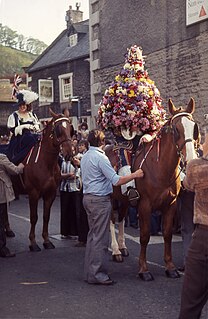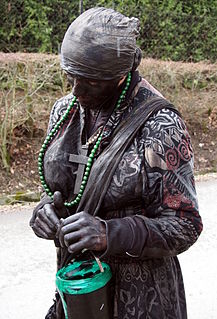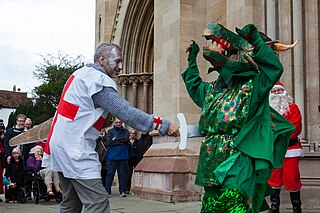
Halloween costumes are costumes worn on or around Halloween, a festival which falls on October 31. An early reference to wearing costumes at Halloween comes from Scotland in 1585, but they may pre-date this. There are many references to the custom during the 18th and 19th centuries in the Celtic countries of Scotland, Ireland, Mann and Wales. It has been suggested that the custom comes from the Celtic festivals of Samhain and Calan Gaeaf, or from the practise of "souling" during the Christian observance of Allhallowtide. Wearing costumes and mumming has long been associated with festivals at other times of the year, such as on Christmas. Halloween costumes are traditionally based on frightening supernatural or folkloric beings. However, by the 1930s costumes based on characters in mass media such as film, literature, and radio were popular. Halloween costumes have tended to be worn mainly by young people, but since the mid-20th century they have been increasingly worn by adults also.

Castleton is a village in the High Peak district of Derbyshire, England, at the western end of the Hope Valley on the Peakshole Water, a tributary of the River Noe, between the Dark Peak to the north and the White Peak to the south. The population was 642 at the 2011 Census.

Tideswell is a village and civil parish in the Peak District of Derbyshire, England. It lies 6 miles (9.7 km) east of Buxton on the B6049, in a wide valley on a limestone plateau, at an altitude of 1,000 feet (300 m) above sea level, and is within the District of Derbyshire Dales. The population was 1,820 in 2001, increasing slightly to 1,827 at the 2011 Census, making it the second-largest settlement within the National Park, after Bakewell. Tideswell Dale is a short limestone valley leading south from the village to the River Wye valley.

Westhoughton is a town and civil parish in the Metropolitan Borough of Bolton, Greater Manchester, England. It is 4 miles (6 km) southwest of Bolton, 5 miles (8 km) east of Wigan and 13 miles (21 km) northwest of Manchester.

The Mummers Parade is held each New Year's Day in Philadelphia. Local clubs compete in one of five categories. They prepare elaborate costumes, performance routines, and movable scenery, which take months to complete. This is done in clubhouses – many of which are on or near 2nd Street in the Pennsport neighborhood of the city's South Philadelphia section – which also serve as social gathering places for members.

Up Helly Aa can refer to any of twelve fire festivals held annually from January to March in Shetland, Scotland, to mark the end of the yule season. Each festival involves a torchlit procession by squads of costumed participants that culminates in the burning of Viking galley. The main festival held in Lerwick, Shetland's capital, involves a procession of up to a thousand guizers who march through the streets of Lerwick on the last Tuesday in January. The other rural festivals see lower numbers of participants in accordance with their lower populations.

Guise dancing is a form of community mumming practiced during the twelve days of Christmastide, that is, between Christmas Day and Twelfth Night in West Cornwall, England, UK. Today, guise dancing has been appropriated for feast days at other times of the year.

Tideswell Community Players, the amateur theatre group of Tideswell in the Peak District, United Kingdom was formed in 1929. They performed their first play, Ambrose Applejohn's Adventure, by Walter Hackett in 1930. Their first logo was the woodblock print pictured.
Mummer's Day, or "Darkie Day" as it is sometimes known, is a traditional Cornish midwinter celebration that occurs every year on Boxing Day and New Year's Day in Padstow, Cornwall. It was originally part of the pagan heritage of midwinter celebrations that were regularly celebrated throughout Cornwall where people would take part in the traditional custom of guise dancing, which involves disguising themselves by painting their faces black or wearing masks.

Little Hucklow is a village and civil parish in Derbyshire. Whilst it is a separate civil parish in the Derbyshire Dales District, the Parish Council is joint with Great Hucklow, and Grindlow. The parish consists of the village of Little Hucklow and the hamlets of Coplow Dale and Windmill.

The Dorset Ooser is a wooden head that featured in the 19th-century folk culture of Melbury Osmond, a village in the southwestern English county of Dorset. The head was hollow, thus perhaps serving as a mask, and included a humanoid face with horns, a beard, and a hinged jaw which allowed the mouth to open and close. Although sometimes used to scare people during practical jokes, its main recorded purpose was as part of a local variant of the charivari custom known as "skimity riding" or "rough music", in which it was used to humiliate those who were deemed to have behaved in an immoral manner.

A straw bear is a traditional character that appears in carnival processions or as a separate seasonal custom in parts of Germany, mainly at Shrovetide but sometimes at Candlemas or Christmas Eve.

The term 'hobby horse' is used, principally by folklorists, to refer to the costumed characters that feature in some traditional seasonal customs, processions and similar observances around the world. They are particularly associated with May Day celebrations, mummers' plays and the Morris dance in England.

Castleton Garland Day or Garland King Day is held annually on 29 May in the town of Castleton in the Derbyshire Peak District. The Garland King, on horseback, and covered to the waist in a heavy, bell-shaped floral garland, leads a procession through the town.
The Winster Guisers are a group who perform a traditional mummers play in and around the village of Winster, Derbyshire, UK, during the Christmas season. Their performance is based on a photograph taken c. 1870 outside Winster Hall showing an unidentified set of performers about whom little is known for certain. The Winster Guisers' play is not local to the area, but is a revival of a Cheshire play, chosen because it features a hobby horse similar to the one in the centre of the old photograph. A "guiser" is someone in disguise, though in the Winster area the term was widely used for the teams of Christmas mummers.

Siuda Baba is an old Polish folk custom, celebrated on Easter Monday and surviving today in only a handful of villages surrounding Kraków. The character of Siuda Baba is performed by a local man who dresses up as a shabbily clothed woman whose face is blackened with soot. Siuda Baba walks from house to house, accompanied by other characters – a Gypsy and Krakowiacy. The group visits houses, collecting donations and smearing girls' faces with soot.

Old Tup, sometimes termed the Derby Tup or the Derby Ram, is a folk custom found in an area of north-eastern England. Geographically, the custom was found on the borders of Derbyshire and Yorkshire and stretched into part of Nottinghamshire. The tradition entails the use of a hobby horse with a goat's head that is mounted on a pole and carried by an individual hidden under a sackcloth. It represents a regional variation of a "hooded animal" tradition that appears in various forms throughout the British Isles. In geographical location and style it displays strong similarities with the Old Horse custom, but in the latter the hobby horse was presented as a horse rather than a goat.

Mummers' plays are folk plays performed by troupes of amateur actors, traditionally all male, known as mummers or guisers. It refers particularly to a play in which a number of characters are called on stage, two of whom engage in a combat, the loser being revived by a doctor character. This play is sometimes found associated with a sword dance though both also exist in Britain independently.

Tideswell Dale is a short dry limestone valley near Tideswell village, Derbyshire, in the Peak District of England. There is a farmland plateau on either side. The foot of the valley leads into Miller's Dale on the River Wye, which the valley's Brook Head stream runs into.

The Wye Valley is the limestone valley of the River Wye in the White Peak of Derbyshire, England. The source of the River Wye is west of Buxton on Axe Edge Moor. One main channel runs underground through Poole's Cavern. The river flows though Buxton Pavilion Gardens and then along a culvert under the town centre. After leaving the flat area of central Buxton, the Wye Valley becomes distinct as a gorge running east for 10 miles (16 km) before the valley broadens at Ashford-in-the Water.


















